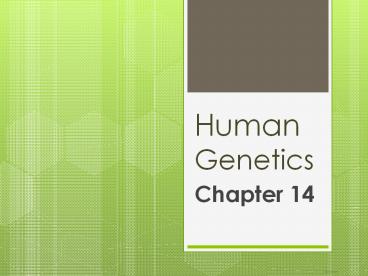Human Genetics - PowerPoint PPT Presentation
1 / 20
Title:
Human Genetics
Description:
Human Genetics Chapter 14 Human Chromosomes How many kinds of chromosomes do humans have? 23 How many chromosomes do humans have? 46 (23 from each parent) What are ... – PowerPoint PPT presentation
Number of Views:219
Avg rating:3.0/5.0
Title: Human Genetics
1
Human Genetics
- Chapter 14
2
Human Chromosomes
- How many kinds of chromosomes do humans have?
- 23
- How many chromosomes do humans have?
- 46 (23 from each parent)
- What are the sex chromosomes?
- The two chromosomes that determine your sex (X
Y females XX males XY) The X is much
larger (X has 1200 genes Y has about 140).
3
Human Chromosomes
- What are autosomes (autosomal chromosomes)?
- The other 22 chromosomes that are not sex
chromosomes. (they are named chromosomes 1, 2, 3
. . . 22) - The sex chromosomes are the 23rd pair.
4
Human Chromosomes
- What is a karyotype?
- An arrangement of pictures of chromosomes taken
during metaphase. This picture is called a
metaphase spread. - 2. Chromosomes are arranged based on size,
centromere location, and banding patterns. (The
banding was the inspiration for bar codes.) - 3. Karyotypes are used to diagnose genetic
disorders based on chromosomal number and for sex
determination.
5
Human Chromosomes
Metaphase Spread
Karyotype of a normal human male. 46,XY
6
Human Pedigree
- What is a pedigree?
- It is a chart that traces a Mendelian trait
through a family.
7
- Examples of Autosomal Dominant Traits
- Dwarfism
- Progeria
- Polydactyly and Syndactyly
- Examples of Autosomal Recessive Traits
- Albinism
- Cystic Fibrosis
- Phenylketoneuria (PKU)
8
Human Blood Types
- ABO blood types are traits inherited by multiple
alleles that show both codominance complete
dominance. - Rh blood group determines the () or () part of
the blood type. () is completely dominant over
the ().
9
Human Autosomal Disorders
10
Cystic Fibrosis
- Caused by a recessive allele on chromosome 7 that
affects a chloride ion channel in the plasma/cell
membrane. The CFTR protein folds improperly. - Causes the production of a thick mucus that
interferes with digestion breathing. - Allele is found in populations originating from
Northern Europe. The heterozygous people during
the Middle Ages had an evolutionary advantage
against typhoid fever.
11
Sickle Cell Disease
- Found in people of Sub-Saharan African descent.
- The allele is the result of a point mutation that
changes just one amino acid in hemoglobin. - The affected hemoglobin causes the red blood
cells to be misshapen when O2 levels drop. - The allele shows codominance (sickle beta-globin
gene along with the normal beta-globin gene).
Homozygous recessive people are most affected,
heterozygous are partially affected, and
homozygous dominant are not affected. - The allele is relatively common because the
heterozygous people have resistance to malaria.
12
Sickle Cell Disease
13
Human Chromosomes
- Each diploid cell has 6 billion base pairs.
- Only 2 actually codes for proteins.
- The average gene is 3000 base pairs the longest
is 2 million base pairs.
PS-1, PS-2, APOE, APP are all genes involved in
Alzheimers Disease
14
Sex-Linked Traits
- These are traits whose genes are found on one of
the sex chromosomes. - Most of these genes are found on the X chromosome
because it is larger. - X-linked traits have a tendency to show up more
in males because they only have one X chromosome.
15
Sex-Linked Traits
- Red/Green Colorblindness
- X-linked recessive allele
- Cant see the colors red and green very well.
- Most common in males.
16
Sex-Linked Traits
XH
Xh
- Hemophilia
- X-linked recessive
- One of the proteins that is involved in the
clotting process is defective. - Once known as the royal disease because it was
common in the royal families of Europe.
XHXH
XHXh
XH
XHY
XhY
Y
17
Sex-Linked Traits
- Duchenne Muscular Dystrophy
- X-linked recessive
- Causes progressive weakening loss of skeletal
muscle. - Affects 1 out of 3000 American males
18
X-Chromosome Inactivation
- In females, one of the X chromosomes is randomly
inactivated. - This process is called Lyonization after Mary
Lyon, the scientist who discovered it. - The inactive X chromosome forms a dense region in
the nucleus called a Barr body. - This phenomenon can cause interesting traits like
the calico color pattern in cats. The genes for
the black and orange color are on the X
chromosome.
19
Nondisjunction
- Sometimes during meiosis, the homologous
chromosomes fail to separate. - This causes the gametes to have more or less than
23 chromosomes. - Down Syndrome is caused by nondisjunction of
chromosome 21. - One gamete had two copies of chromosome 21. The
resulting child has 3 copies of chromosome 21
(trisomy 21)
20
Nondisjunction
- Nondisjunction can also occur with the sex
chromosomes. - Turners Syndrome (monosomy X)
- - 45,X (1 in 2500 females)
- - Mentally normal, typically short, webbed
neck, sterile, underdeveloped sex organs 2o sex
characteristics, heart problems. - B. Klinefelters Syndrome (47, XXY)
- - 1 in 1000 males
- - Some cognitive problems, tall slim, some
female 2o sex characteristics, sterile.































